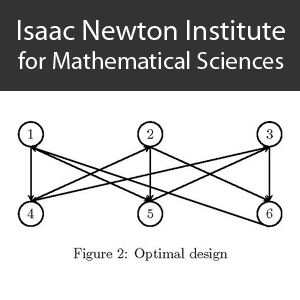D-optimal designs for Two-Variable Binary Logistic Models with Interaction
26 mins,
192.13 MB,
WebM
640x360,
29.97 fps,
44100 Hz,
0.98 Mbits/sec
Share this media item:
Embed this media item:
Embed this media item:
About this item

| Description: |
Haines, L (Cape Town)
Wednesday 31 August 2011, 15:00-15:30 |
|---|
| Created: | 2011-09-01 14:58 | ||||
|---|---|---|---|---|---|
| Collection: | Design and Analysis of Experiments | ||||
| Publisher: | Isaac Newton Institute | ||||
| Copyright: | Haines, L | ||||
| Language: | eng (English) | ||||
| Credits: |
|
||||
| Abstract: | It is not uncommon for medical researchers to administer two drugs simultaneously to a patient and to monitor the response as binary, that is either positive or negative. Interest lies in the interaction of the drugs and specifically in whether that interaction is synergistic, antagonistic or simply additive. A number of statistical models for this setting have been proposed in the literature, some complex, but arguably the most widely used is the two-variable binary logistic model which can be formulated succinctly as ln (p/(1-p)) = beta0 + beta1 x1 + beta2 x2 + + beta12 x1 x2 (*) where p is the probability of a positive response, x1 and x2 are the doses or log-doses of the drugs and beta0, beta1, beta2 and beta12 are unknown parameters. There is a broad base of research on the fitting, analysis and interpretation of this model but, somewhat surprisingly, few studies on the construction of the attendant optimal designs. In fact there are two substantive reports on this design problem, both unpublished, namely the Ph.D. thesis of Kupchak (2000) and the technical report of Jia and Myers (2001). In this talk the problem of constructing D-optimal designs for the model (*) is addressed. The approach builds on that of Jia and Myers (2001) with design points represented in logit space and lying on hyperbolae in that space. Algebraic results proved somewhat elusive and just two tentative propositions are given. To counter this, a taxonomy of designs, obtained numerically and dictated by the values of the unknown parameters, is also reported. This work forms part of the Ph.D. thesis of Kabera (2009) and is joint with Gaetan Kabera of the Medical Research Council of South Africa and Prince Ndlovu of the University of South Africa. References Jia Y. and Myers R.H. (2001). “Optimal Experimental Designs for Two-variable Logistic Regression Models.” Technical Report, Department of Statistics, VPI & SU, Backsberg, Virginia. Kabera M.G. (2009). “D-optimal Designs for Drug Synergy.” Ph.D. thesis, University of KwaZulu-Natal. Kupchak P.I. (2000). “Optimal Designs for the Detection of Drug Interaction.” Ph.D. thesis, University of Toronto. |
|---|---|
Available Formats
| Format | Quality | Bitrate | Size | |||
|---|---|---|---|---|---|---|
| MPEG-4 Video | 640x360 | 1.84 Mbits/sec | 361.29 MB | View | Download | |
| WebM * | 640x360 | 0.98 Mbits/sec | 192.13 MB | View | Download | |
| Flash Video | 484x272 | 569.07 kbits/sec | 108.58 MB | View | Download | |
| iPod Video | 480x270 | 506.25 kbits/sec | 96.65 MB | View | Download | |
| MP3 | 44100 Hz | 125.01 kbits/sec | 23.67 MB | Listen | Download | |
| Auto | (Allows browser to choose a format it supports) | |||||

